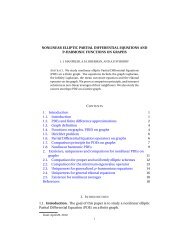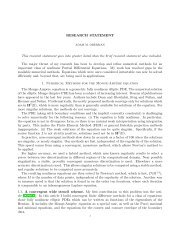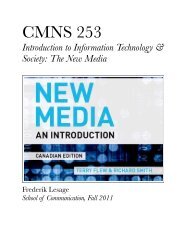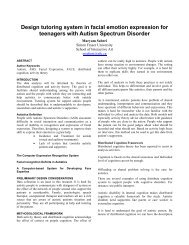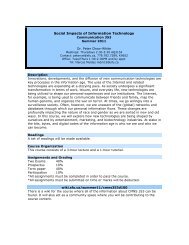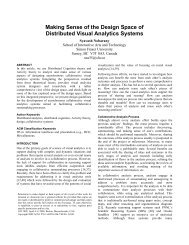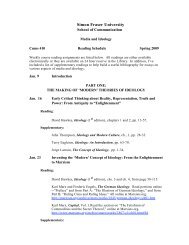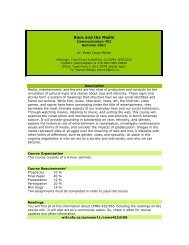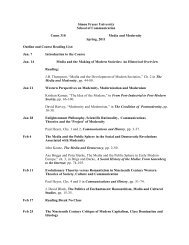Monge.. - SFU Wiki
Monge.. - SFU Wiki
Monge.. - SFU Wiki
You also want an ePaper? Increase the reach of your titles
YUMPU automatically turns print PDFs into web optimized ePapers that Google loves.
8 JEAN-DAVID BENAMOU, BRITTANY D. FROESE, AND ADAM M. OBERMANsingle Poisson solve. Each iteration of [9, 15, 7, 8, 10] involves a Poisson solve andadditional calculations.Feng and Neilan [14, 12, 13] do not give details about the computation time oriteration count of their numerical method.3.2. Comparison of Method 1 and Method 2. The computation time for (M1)was roughly independent of the regularity of the solution. On the other hand, thecomputation times for (M2) were faster (by more than one order of magnitude) onvery smooth solutions, about equal on mildly singular solutions, and much slower(by a couple of orders of magnitude) on the more singular solutions.Naturally, for any finite resolution, the discretised solutions are not singular, sowe cannot conclude that the method diverges. But since the relative computationalcosts increase dramatically as the solutions become less regular, this behavior isconsistent with divergence.We find (M2) performs extremely rapidly when solutions are smooth, but isvery slow when solutions are not smooth or not strictly convex. The explicitmethod (M1), on the other hand, requires approximately the same amount of CPUtime to converge without regard for the regularity of the solutions.To show this more concretely, we consider a representative example from eachcategory: the smooth radial solution of §4.1, the example with noisy data of §5.1,and the non-smooth cone of §6.1. We compare the absolute computation timerequired for these three examples to demonstrate our observation that the speedof (M1) is independent of regularity while the speed of (M2) is very sensitive toregularity; see Figure 1. We compare the ratio of CPU times required by the twomethods for a representative example, see Table 1.(a)fig:Meth1(b)fig:Meth2Figure 1. CPU time required to converge for the smooth radialsolution of §4.1, the noisy solution of §5.1, and the non-smoothcone of §6.1. (a) Results for (M1). (b) Results for (M2).fig:times3.3. Computational Details. The solutions are computed on an N × N gridand iteration is continued until the maximum difference between two subsequentiterates is less than 10 −14 . By convention, h is the spatial discretisation parameterh = L/N where L is the length of one side of the square domain.



